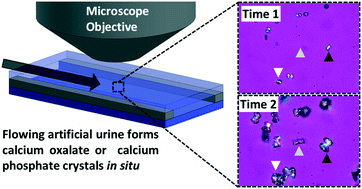In situ flow cell platform for examining calcium oxalate and calcium phosphate crystallization on films of basement membrane extract in the presence of urinary ‘inhibitors’†
Abstract
A significant portion of the population suffers from idiopathic calcium oxalate (CaOx) kidney stones, and current clinical treatments of stones have limited lasting success with a high rate of patients suffering from reoccurring stones. Understanding the role of physiologically relevant urinary species on the formation, aggregation, and growth of CaOx crystals can allow for better understanding of this complex biomineralization process and lead to more effective clinical treatments. Our prior work has focused on developing a two-stage model system, where the first stage emulates the formation of Randall's plaque, and the second stage examines the influence of the plaque on overgrowth of CaOx into a stone. Herein, we report on the development of an easy-to-use flow-cell platform that utilizes basement membrane extract (BME) as a biologically relevant crystallization substrate to study the influence of urinary ‘inhibitors’ on the in situ formation and growth of CaOx on BME under flow conditions. Magnesium, citrate, and osteopontin were studied because of their known ability to inhibit CaOx formation, but their influence also led to interesting modifications to the terminal crystal habit. Magnesium had little to no effect on the CaOx crystallization, but both citrate and osteopontin resulted in significant changes to the crystallization kinetics and the terminal crystal habits. Triply inhibited artificial urine solutions resulted in CaOx monohydrate formations that resembled physiological stones, and the in situ platform allowed for morphogenesis to be dynamically monitored. The BME was also used in a two-stage model system to first grow CaP that mimicked Randall's plaques, whereby the impact of the CaP crystallizing surface on CaOx formation could be studied. It was found that the CaP surface did not result in any significant changes in CaOx crystal formation or growth indicating that the urinary inhibitors and the basement membrane substrate were the dominant factors in modulating CaOx crystallization. It was also found that the basement membrane surface promoted the attachment and/or nucleation and growth of both CaOx and CaP crystals compared to bare glass surfaces, thereby enabling easy study of the urinary inhibitors. The work presented here has elucidated the terminal growth habit of different COM structures and has provided an easy to use platform that can be widely adopted by the kidney stone and other crystallization communities.



 Please wait while we load your content...
Please wait while we load your content...